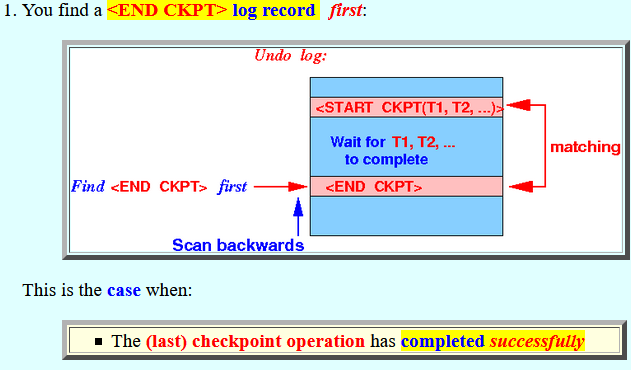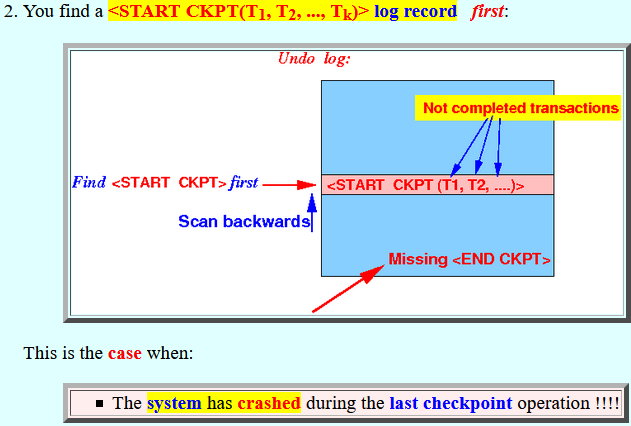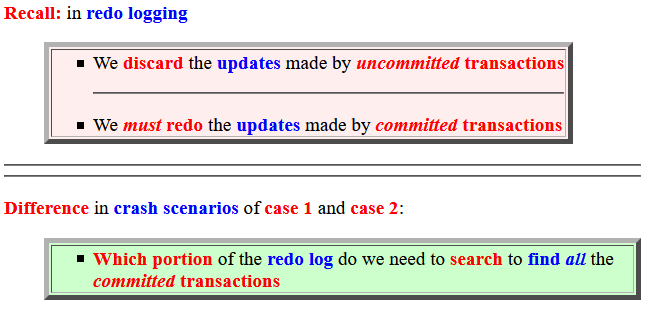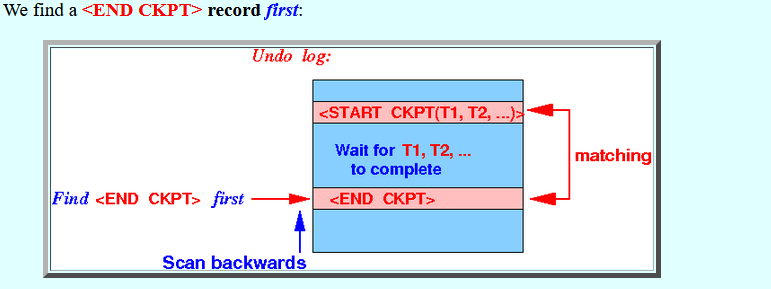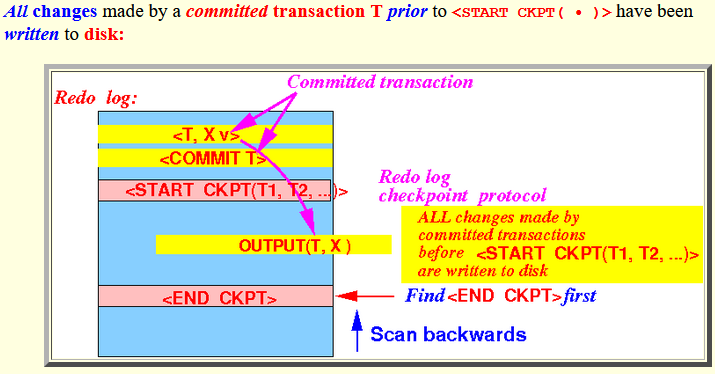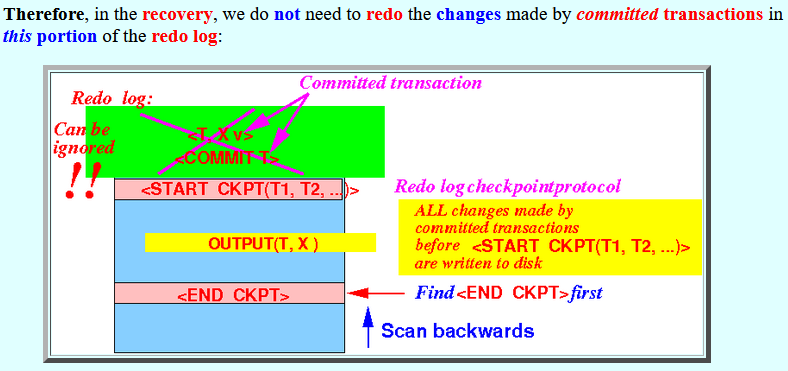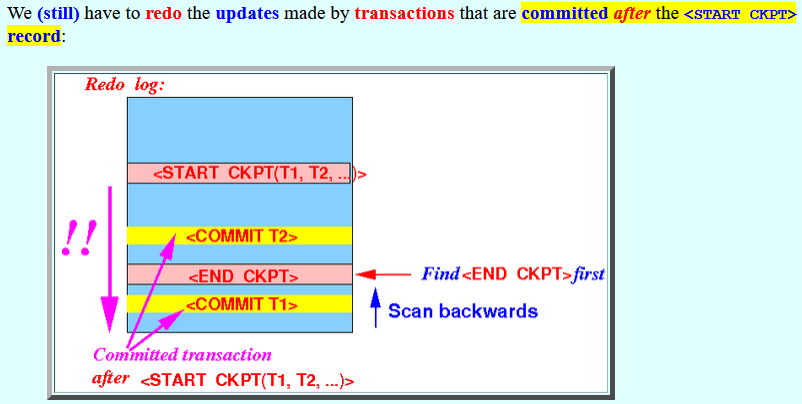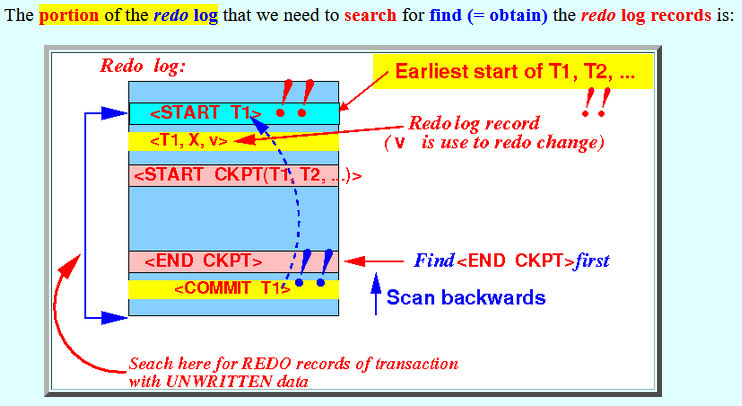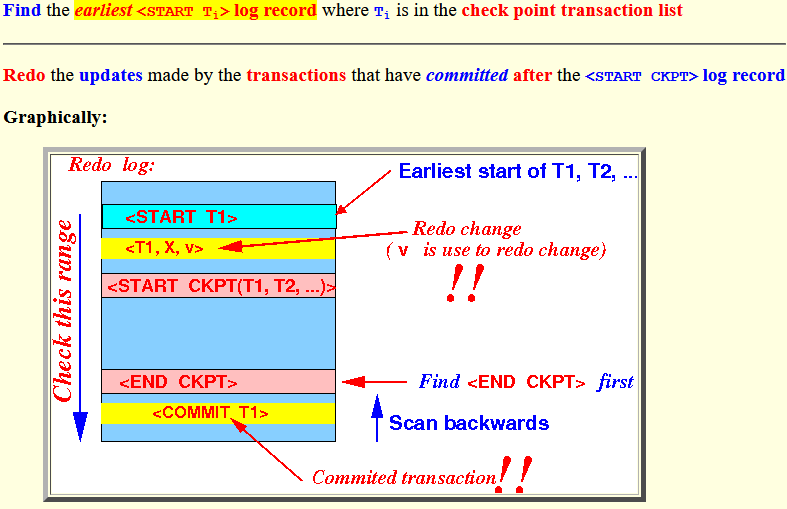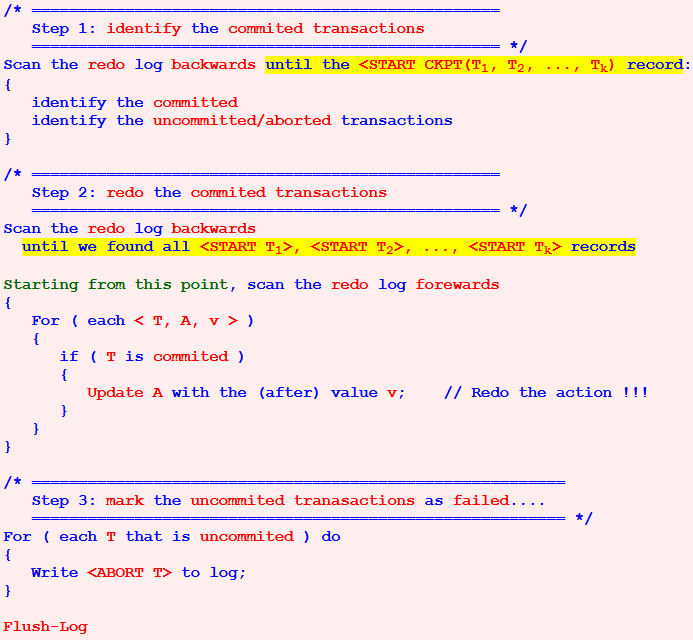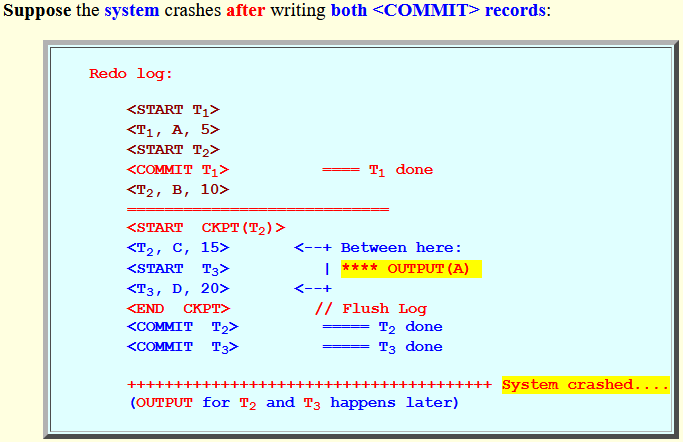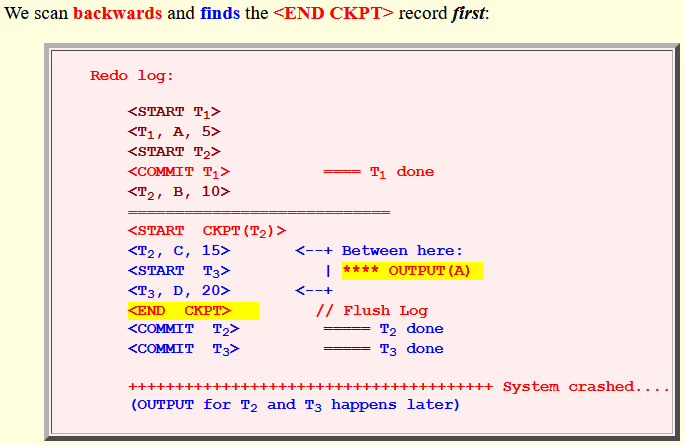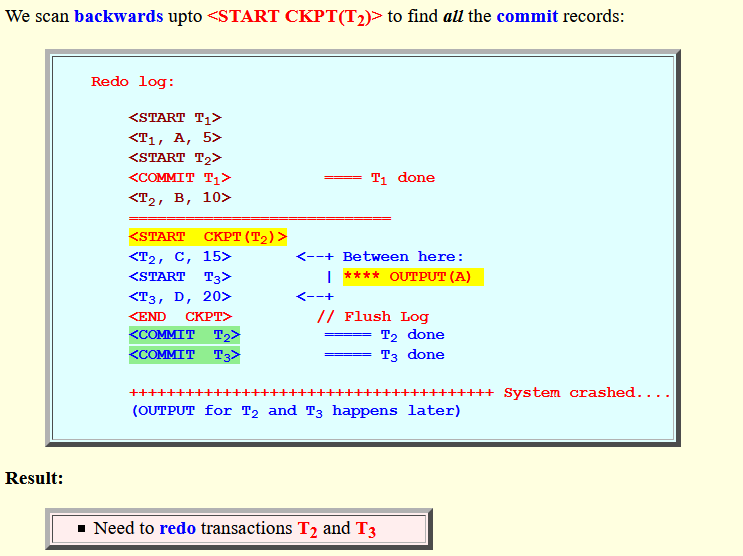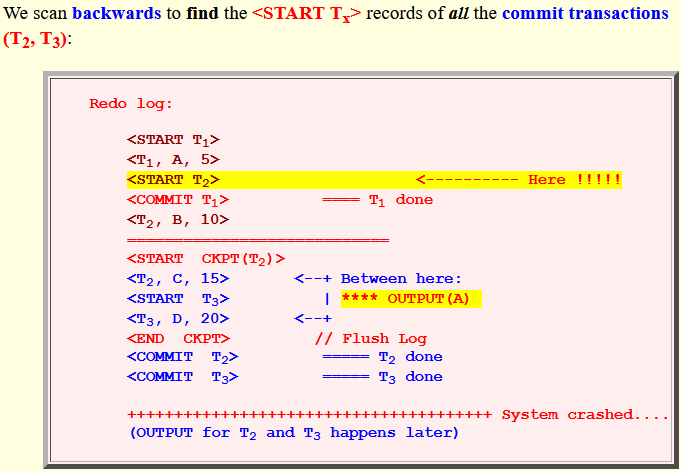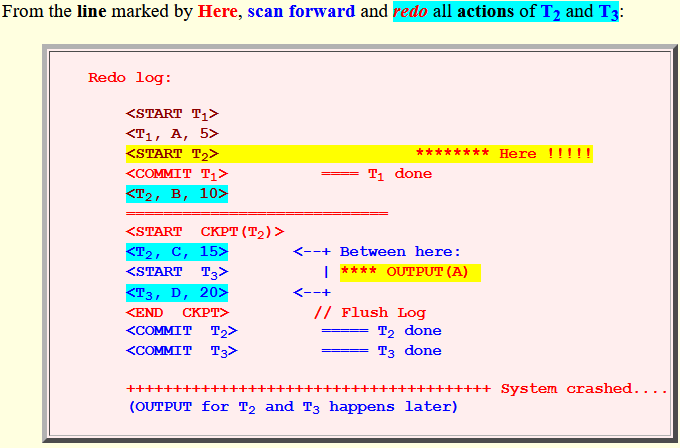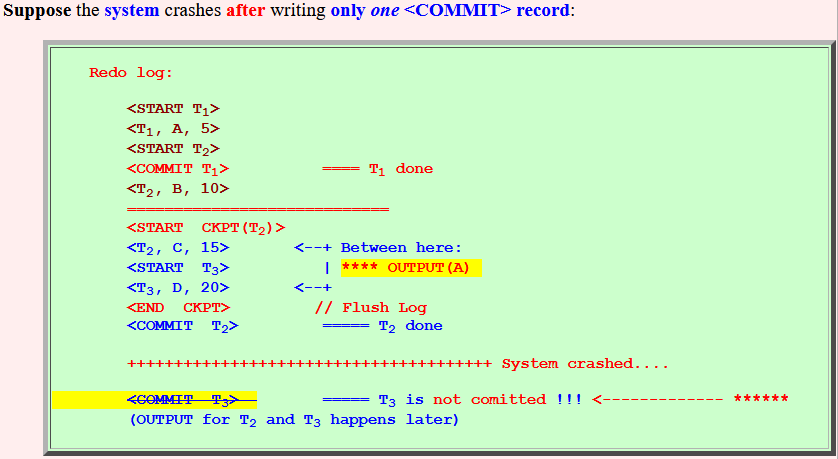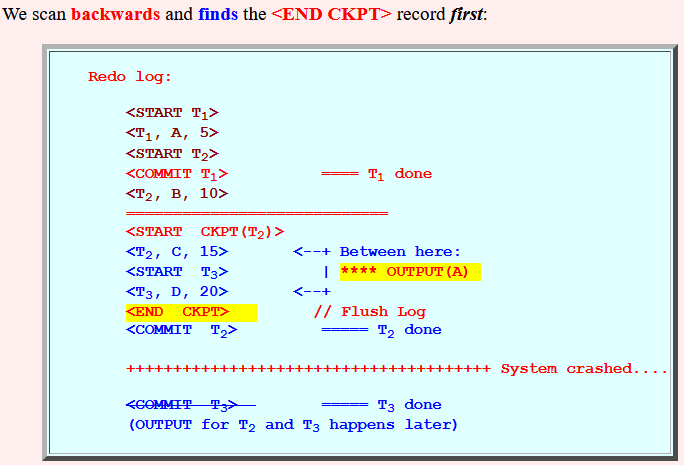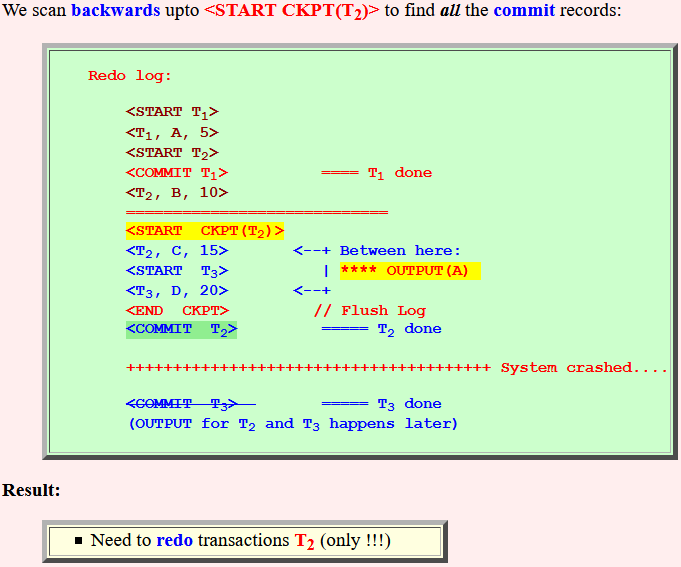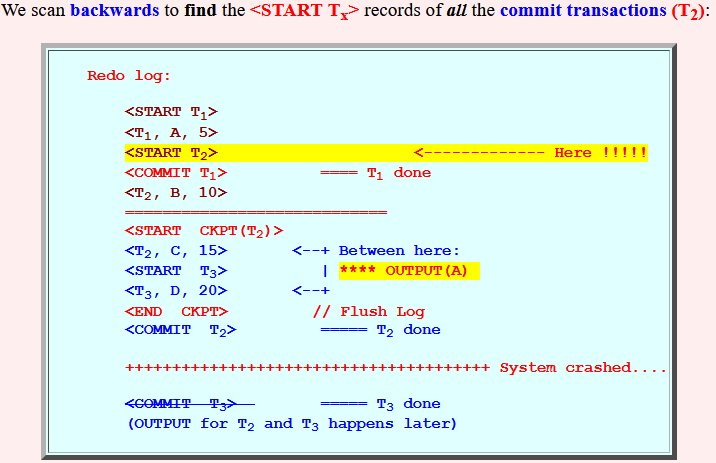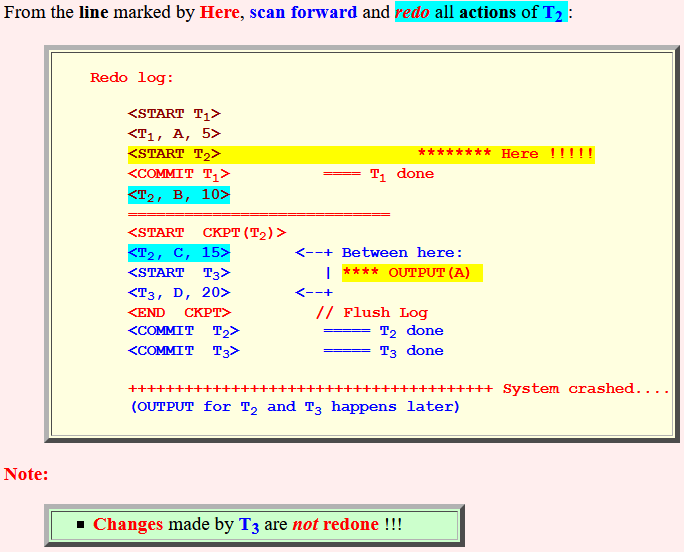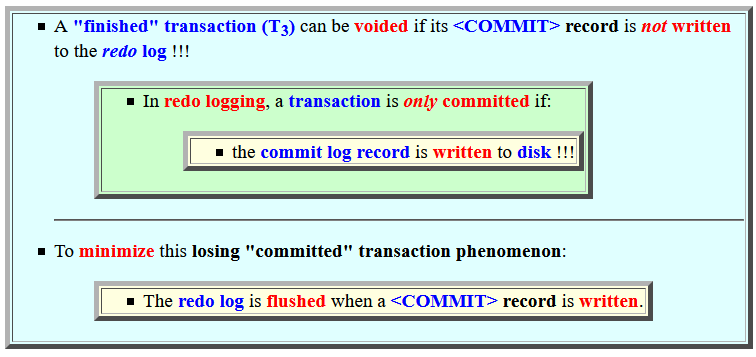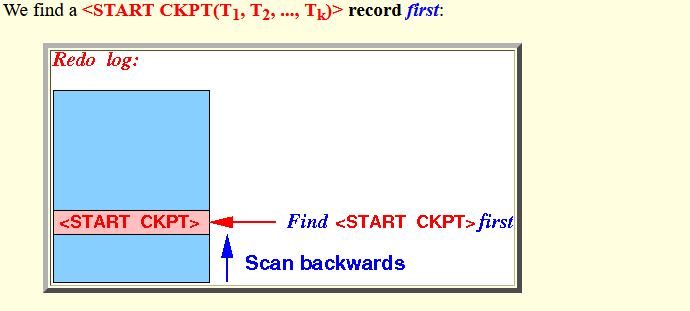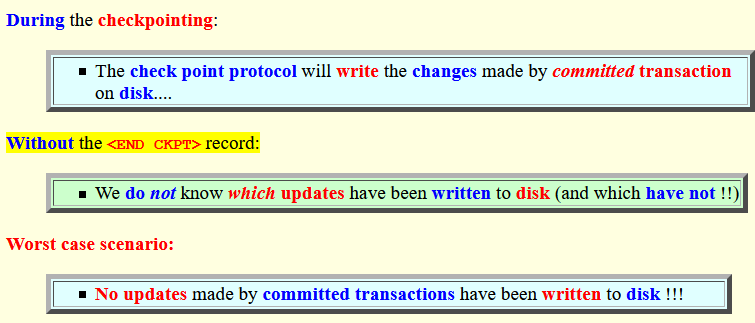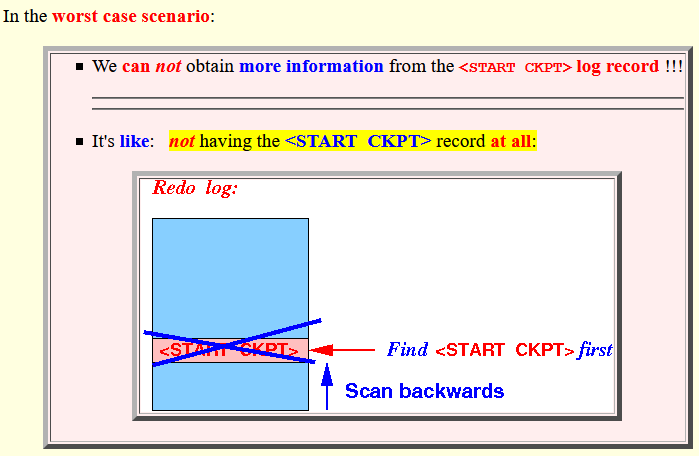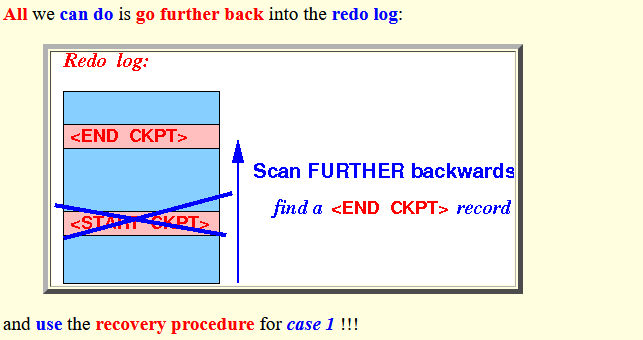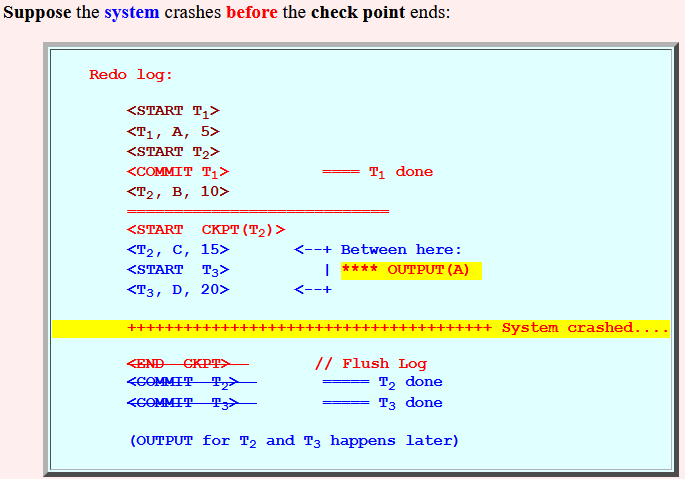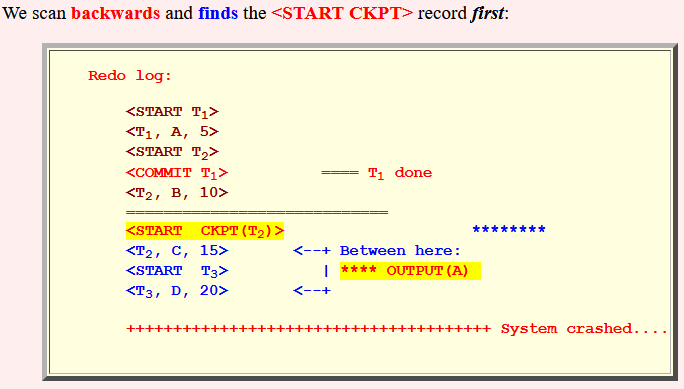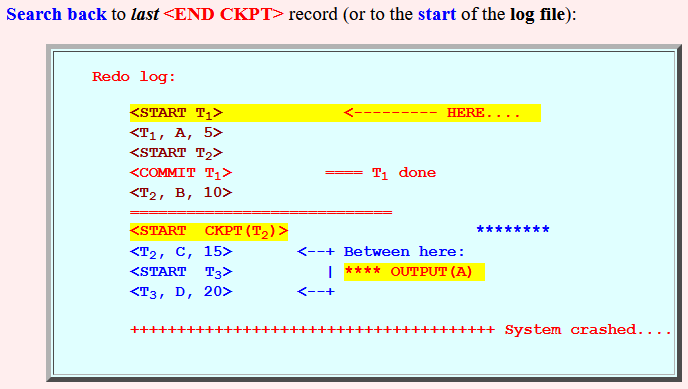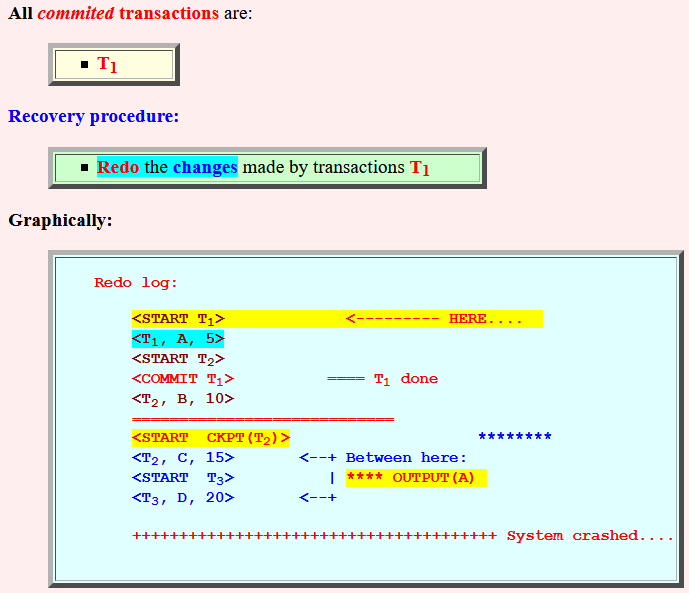Slideshow:
- When scanning the log file
backwards, you can
find one of the
following:
- You find a <END CKPT> record
first:

This is the case when:
- The last checkpoint operation has completed successfully
- You find a <START
CKPT(T1, T2, ..., Tk)>
record
first:
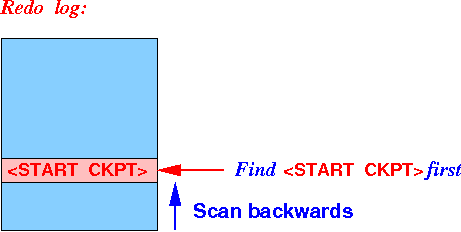
This is the case when:
- The system has crashed during the last checkpoint operation !!!!
- You find a <END CKPT> record
first:
- Recall:
in redo logging
- We discard the
updates made by
uncommitted transactions
- We must redo the updates made by committed transactions
- We discard the
updates made by
uncommitted transactions
- Difference in
crash scenarios
of
case 1 and
case 2:
- Which portion of the redo log do we need to search to find all the committed transactions
- Where to
find the
necessary redo log records
in case 1:
- Given that
we find a <END CKPT> record
first:

-
By the
checkpointing algorithm:
- All changes made by a
committed transaction T
prior to
<START CKPT( • )>
have been
written to
disk:

- All changes made by a
committed transaction T
prior to
<START CKPT( • )>
have been
written to
disk:
- Therefore, in the recovery,
we do not need to
redo the
changes made
by
committed transactions in
this portion
of the redo log:
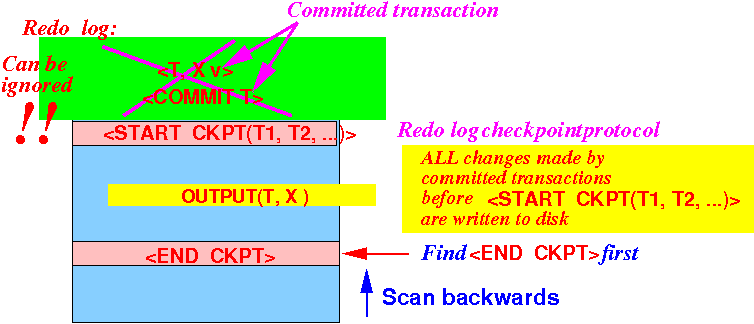
We (still) have to redo the updates made by transactions that are committed after the <START CKPT> record:
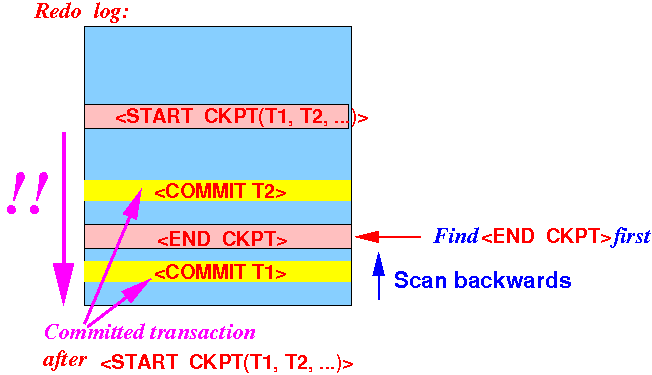
-
The
portion of the
redo log
that we need to search for
find (= obtain) the
redo log records is:

- Given that
we find a <END CKPT> record
first:
- Summary:
how to
recover using
redo logging in
case 1:
- Find the
earliest
<START Ti> log record
where
Ti is
in the check point transaction list
- Redo
the updates made by
the transactions that have
committed
after the
<START CKPT> log record
Graphically:

- Find the
earliest
<START Ti> log record
where
Ti is
in the check point transaction list
- Recovery Algorithm
of redo logging
for case 1:
/* ================================================== Step 1: identify the commited transactions ================================================== */ Scan the redo log backwards until the <START CKPT(T1, T2, ..., Tk) record: { identify the committed identify the uncommitted/aborted transactions } /* ================================================== Step 2: redo the commited transactions ================================================== */ Scan the redo log backwards until we found all <START T1>, <START T2>, ..., <START Tk> records Starting from this point, scan the redo log forewards { For ( each < T, A, v > ) { if ( T is commited ) { Update A with the (after) value v; // Redo the action !!! } } } /* ========================================================= Step 3: mark the uncommited tranasactions as failed.... ========================================================= */ For ( each T that is uncommited ) do { Write <ABORT T> to log; } Flush-Log
- Example 1:
- Suppose the
system
crashes after writing
both <COMMIT> records:
Redo log: <START T1> <T1, A, 5> <START T2> <COMMIT T1> ==== T1 done <T2, B, 10> ============================ <START CKPT(T2)> <T2, C, 15> <--+ Between here: <START T3> | **** OUTPUT(A) <T3, D, 20> <--+ <END CKPT> // Flush Log <COMMIT T2> ===== T2 done <COMMIT T3> ===== T3 done +++++++++++++++++++++++++++++++++++++++ System crashed.... (OUTPUT for T2 and T3 happens later)
- We scan backwards and
finds the
<END CKPT> record
first:
Redo log: <START T1> <T1, A, 5> <START T2> <COMMIT T1> ==== T1 done <T2, B, 10> ============================ <START CKPT(T2)> <T2, C, 15> <--+ Between here: <START T3> | **** OUTPUT(A) <T3, D, 20> <--+ <END CKPT> // Flush Log <COMMIT T2> ===== T2 done <COMMIT T3> ===== T3 done +++++++++++++++++++++++++++++++++++++++ System crashed.... (OUTPUT for T2 and T3 happens later)
- We scan backwards
upto
<START CKPT(T2)>
to
find all the
commit records:
Redo log: <START T1> <T1, A, 5> <START T2> <COMMIT T1> ==== T1 done <T2, B, 10> ============================ <START CKPT(T2)> <T2, C, 15> <--+ Between here: <START T3> | **** OUTPUT(A) <T3, D, 20> <--+ <END CKPT> // Flush Log <COMMIT T2> ===== T2 done <COMMIT T3> ===== T3 done +++++++++++++++++++++++++++++++++++++++ System crashed.... (OUTPUT for T2 and T3 happens later)Result:
- Need to redo transactions T2 and T3
- We scan backwards
to find the
<START Tx>
records of all the
commit transactions
(T2, T3):
Redo log: <START T1> <T1, A, 5> <START T2> <---------- Here !!!!! <COMMIT T1> ==== T1 done <T2, B, 10> ============================ <START CKPT(T2)> <T2, C, 15> <--+ Between here: <START T3> | **** OUTPUT(A) <T3, D, 20> <--+ <END CKPT> // Flush Log <COMMIT T2> ===== T2 done <COMMIT T3> ===== T3 done +++++++++++++++++++++++++++++++++++++++ System crashed.... (OUTPUT for T2 and T3 happens later)
-
From the line marked by Here,
scan forward and
redo all
actions of
T2 and
T3:
Redo log: <START T1> <T1, A, 5> <START T2> ******** Here !!!!! <COMMIT T1> ==== T1 done <T2, B, 10> ============================ <START CKPT(T2)> <T2, C, 15> <--+ Between here: <START T3> | **** OUTPUT(A) <T3, D, 20> <--+ <END CKPT> // Flush Log <COMMIT T2> ===== T2 done <COMMIT T3> ===== T3 done +++++++++++++++++++++++++++++++++++++++ System crashed.... (OUTPUT for T2 and T3 happens later)
- Suppose the
system
crashes after writing
both <COMMIT> records:
- Note: (log record pointers)
- To limit the scanning to redo the actions of committed transaction, we will discuss log record pointers later
- Example 2:
(losing a
completed (but uncommitted)
transaction)
- Suppose the
system
crashes after writing
only one <COMMIT> record:
Redo log: <START T1> <T1, A, 5> <START T2> <COMMIT T1> ==== T1 done <T2, B, 10> ============================ <START CKPT(T2)> <T2, C, 15> <--+ Between here: <START T3> | **** OUTPUT(A) <T3, D, 20> <--+ <END CKPT> // Flush Log <COMMIT T2> ===== T2 done +++++++++++++++++++++++++++++++++++++++ System crashed....<COMMIT T3>===== T3 is not comitted !!! <------------- ****** (OUTPUT for T2 and T3 happens later)
- We scan backwards and
finds the
<END CKPT> record
first:
Redo log: <START T1> <T1, A, 5> <START T2> <COMMIT T1> ==== T1 done <T2, B, 10> ============================ <START CKPT(T2)> <T2, C, 15> <--+ Between here: <START T3> | **** OUTPUT(A) <T3, D, 20> <--+ <END CKPT> // Flush Log <COMMIT T2> ===== T2 done +++++++++++++++++++++++++++++++++++++++ System crashed....<COMMIT T3>===== T3 done (OUTPUT for T2 and T3 happens later)
- We scan backwards
upto
<START CKPT(T2)>
to
find all the
commit records:
Redo log: <START T1> <T1, A, 5> <START T2> <COMMIT T1> ==== T1 done <T2, B, 10> ============================ <START CKPT(T2)> <T2, C, 15> <--+ Between here: <START T3> | **** OUTPUT(A) <T3, D, 20> <--+ <END CKPT> // Flush Log <COMMIT T2> ===== T2 done +++++++++++++++++++++++++++++++++++++++ System crashed....<COMMIT T3>===== T3 done (OUTPUT for T2 and T3 happens later)Result:
- Need to redo transactions T2 (only !!!)
- We scan backwards
to find the
<START Tx>
records of all the
commit transactions
(T2):
Redo log: <START T1> <T1, A, 5> <START T2> <------------- Here !!!!! <COMMIT T1> ==== T1 done <T2, B, 10> ============================ <START CKPT(T2)> <T2, C, 15> <--+ Between here: <START T3> | **** OUTPUT(A) <T3, D, 20> <--+ <END CKPT> // Flush Log <COMMIT T2> ===== T2 done +++++++++++++++++++++++++++++++++++++++ System crashed....<COMMIT T3>===== T3 done (OUTPUT for T2 and T3 happens later)
-
From the line marked by Here,
scan forward and
redo all
actions of
T2
:
Redo log: <START T1> <T1, A, 5> <START T2> ******** Here !!!!! <COMMIT T1> ==== T1 done <T2, B, 10> ============================ <START CKPT(T2)> <T2, C, 15> <--+ Between here: <START T3> | **** OUTPUT(A) <T3, D, 20> <--+ <END CKPT> // Flush Log <COMMIT T2> ===== T2 done <COMMIT T3> ===== T3 done +++++++++++++++++++++++++++++++++++++++ System crashed.... (OUTPUT for T2 and T3 happens later)Note:
- Changes made by T3 are not redone !!!
- Finally, we write an
abort record for
T3:
<ABORT T3>
- Suppose the
system
crashes after writing
only one <COMMIT> record:
- Note:
- A "finished" transaction
(T3)
can be voided if
its
<COMMIT> record
is not written to
the redo log !!!
- In redo logging,
a transaction is
only committed if:
- the commit log record is written to disk !!!
- In redo logging,
a transaction is
only committed if:
- To minimize this
losing "committed" transaction phenomenon:
- The redo log is flushed when a <COMMIT> record is written.
- A "finished" transaction
(T3)
can be voided if
its
<COMMIT> record
is not written to
the redo log !!!
- Recovery algorithm for case 2:
- We find a <START
CKPT(T1, T2, ..., Tk)>
record
first:

During the checkpointing:
- The check point protocol will write the changes made by committed transaction on disk....
Without the <END CKPT> record:
- We do not know which updates have been written to disk (and which have not !!)
Worst case scenario:
- No updates made by committed transactions have been written to disk !!!
- In the worst case scenario:
- We can not obtain
more information
from the
<START CKPT> log record !!!
- It's like:
not having the
<START CKPT>
record at all:
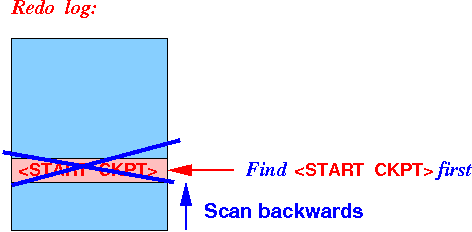
- We can not obtain
more information
from the
<START CKPT> log record !!!
- All we
can do is
go further back into
the redo log:
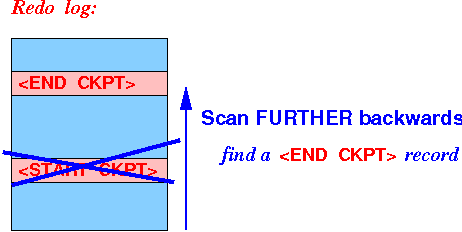
and use the recovery procedure for case 1 !!!
- We find a <START
CKPT(T1, T2, ..., Tk)>
record
first:
- Example:
- Suppose the
system
crashes before
the check point ends:
Redo log: <START T1> <T1, A, 5> <START T2> <COMMIT T1> ==== T1 done <T2, B, 10> ============================ <START CKPT(T2)> <T2, C, 15> <--+ Between here: <START T3> | **** OUTPUT(A) <T3, D, 20> <--+ +++++++++++++++++++++++++++++++++++++++ System crashed....<END CKPT>// Flush Log<COMMIT T2>===== T2 done<COMMIT T3>===== T3 done (OUTPUT for T2 and T3 happens later)
- We scan backwards and
finds the
<START CKPT> record
first:
Redo log: <START T1> <T1, A, 5> <START T2> <COMMIT T1> ==== T1 done <T2, B, 10> ============================ <START CKPT(T2)> ******** <T2, C, 15> <--+ Between here: <START T3> | **** OUTPUT(A) <T3, D, 20> <--+ +++++++++++++++++++++++++++++++++++++++ System crashed....Search back to last <END CKPT> record (or to the start of the log file):
Redo log: <START T1> <--------- HERE.... <T1, A, 5> <START T2> <COMMIT T1> ==== T1 done <T2, B, 10> ============================ <START CKPT(T2)> ******** <T2, C, 15> <--+ Between here: <START T3> | **** OUTPUT(A) <T3, D, 20> <--+ +++++++++++++++++++++++++++++++++++++++ System crashed....All commited transactions are:
- T1
Recovery procedure:
- Redo the changes made by transactions T1
Graphically:
Redo log: <START T1> <--------- HERE.... <T1, A, 5> <START T2> <COMMIT T1> ==== T1 done <T2, B, 10> ============================ <START CKPT(T2)> ******** <T2, C, 15> <--+ Between here: <START T3> | **** OUTPUT(A) <T3, D, 20> <--+ +++++++++++++++++++++++++++++++++++++++ System crashed....Comment:
- This action is correct, because the OUTPUT(A) operation of T1 may not have been executed !!!
- Suppose the
system
crashes before
the check point ends:
- Recall the
recovery algorithm for
an redo log:
/* ================================================== Step 1: identify the commited transactions ================================================== */ Scan the redo log backwards until first <START CKPT(T1, T2, ..., Tk) record: { identify the committed identify the uncommitted/aborted transactions } /* ================================================== Step 2: redo the commited transactions ================================================== */ Scan the redo log backwards until we found all <START T1>, <START T2>, ..., <START Tk> records Starting from this point, scan the redo log forewards { For ( each < T, A, v > where T is commited ) do { Update A with the (after) value v; // Redo the action !!! } } /* ========================================================= Step 3: mark the uncommited tranasactions as failed.... ========================================================= */ For ( each T that is uncommited ) do { Write <ABORT T> to log; } Flush-Log - We can find
all <START T1>,
<START T2>, ..., <START Tk>
records
- Finding the
<START ..> log records
can be expedited if we
include the
position of
all <START T1>,
<START T2>, ..., <START Tk>
records
in the
<START CKPT> record:

